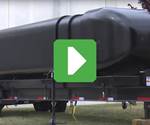3D Printing Autoclavable Composite Molds
A polymer AM research team at ORNL reports it has successfully fabricated autoclave-capable carbon fiber composite molds, manufactured using large-scale 3D printing/additive manufacturing.
The polymer additive manufacturing research team at the Department of Energy’s Manufacturing Demonstration Facility (MDF) at Oak Ridge National Laboratory (Oak Ridge, Tennessee) reports that it has successfully fabricated autoclave-capable carbon fiber composite molds, manufactured using large-scale 3D printing/additive manufacturing.
Oak Ridge National Laboratory (ORNL), in collaboration with numerous industry partners and materials suppliers such as TechmerES (Clinton, Tennessee) and BASF (Wyandotte, Michigan), developed these molds from two high-temperature thermoplastic materials with varying carbon fiber loads, which have been tested and proven in the autoclave process.
The first material combination features polyphenylene sulfide (PPS) reinforced with high loading of carbon fiber supplied by Techmer. The second material combination features a polyphenylsulfone (PPSU) supplied by BASF, compounded by Techmer and with lower carbon fiber loading.
Researchers at ORNL processed the materials on a Big Area Additive Manufacturing (BAAM) machine developed in collaboration with Cincinnati Inc. (Cincinnati, Ohio). They fabricated nine concave-shaped molds in total, each measuring about 1m by 0.8m (see photo). Each tool was either machined and uncoated or coated and not machined, in order to assess vacuum-holding capability of the molds.
Subsequently, the autoclaved molds, trialed at Boeing’s St. Louis facility (St. Louis, Missouri), withstood two cycles at temperatures of 250°F and 30 psi and a second cycle of 350°F and 90 psi for 2-3 hours per cycle. This included a prescribed heat up, a two-hour hold and a prescribed cool down. Dr. Ahmed Hassen, postdoctoral researcher at ORNL, and Dr. Vlastamil Kunc, polymer materials team lead at ORNL, say that the autoclave trials provided promising results, with only 0.002 to 0.004 inch maximum deformation after two cycles. How many autoclave cycles these 3D printed tools might tolerate remains to be determined in future testing.
The benefits of autoclave-capable, 3D printed molds are obvious in terms of time, material and process cost savings opportunities. “Companies can save a lot of time by printing molds in-house. They can have their own printers. They no longer need to wait for months to get their parts made,” says Hassen,.
“It is the understanding of many facets of additive manufacturing and material science which allowed the team to successfully demonstrate how this technology can benefit American tool and die efforts, as well as increase US global manufacturing competitiveness,” says Kunc.
It is expected that autoclave-capable materials for large-scale 3D printing will be commercially available this year.
Related Content
-
In "Hybrid" FIM Process, 3D Printing Complements Injection Molding
In a recent case study, Alpine Advanced Materials partnered with Nexa3D to produce 3D printed tooling for injection molded composites. Utilizing Nexa3D’s XiP desktop 3D printer and its Freeform Injection Molding process, Alpine was able to reduce prototype tooling production time and cost alike for its customers.
-
Robot Vs. Gantry for Large-Format Additive Manufacturing (Includes Video)
Additive Engineering Solutions, specialist at 3D printing very large parts and tools on gantry machines, now also uses a robot for large-format AM. Here is how the robot compares.
-
Copper, New Metal Printing Processes, Upgrades Based on Software and More from Formnext 2023: AM Radio #46
Formnext 2023 showed that additive manufacturing may be maturing, but it is certainly not stagnant. In this episode, we dive into observations around technology enhancements, new processes and materials, robots, sustainability and more trends from the show.














